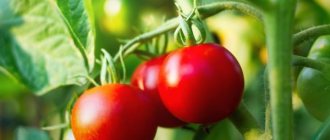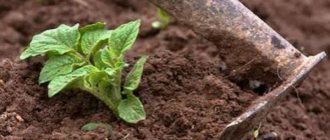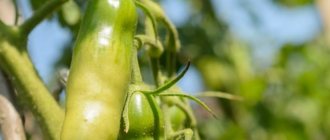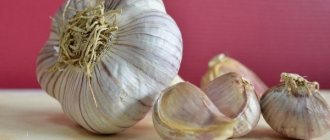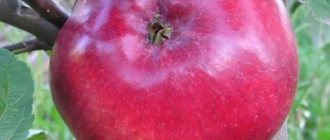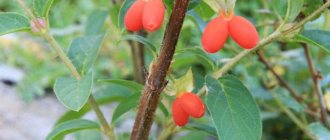Characteristics and description of the variety
The Monomakh Cap tomato was bred by Russian breeders taking into account the different climates in our country. The variety has been known to gardeners for more than 15 years.
Distinctive features
The culture is recommended for cultivation in open ground and in greenhouse conditions. Well adapted to drought.
The height of the bush is up to 1.5 m, the foliage is moderate, the leaves are large, dark green, and do not block the penetration of sunlight.
An early ripening variety, it takes 90–110 days from the first shoots to full ripening.
Productivity is high, from 1 sq. m, up to 20 kg of fruits are collected when placing 3-4 plants per 1 sq. m. m.
The need for garter is determined by the high growth and weight of the developing fruits, which can break loose branches. The crop also needs to be pruned regularly. Increased growth of side shoots will lead to dense plantings.
The culture is highly resistant to the main diseases of the nightshade family, such as late blight and tobacco mosaic virus.
Fruit characteristics
The fruits are large, average weight 450–600 g, round in shape, deep red in color. The taste is sweet with a slight sourness, the flesh is juicy. There are 6–8 seed chambers, the number of seeds is average.
Ripe vegetables are used universally: they are equally suitable for fresh consumption and for winter preparations. Vegetables are also processed into tomato products for making juices, adjika, ketchup and lecho.
Ripe tomatoes have good keeping quality and can withstand transportation over any distance.
The photo shows Monomakh Cap tomatoes.
Landing in the ground
The seedlings are ready for planting 60 days after sowing the seeds. It is important to plant plants in a permanent place when the air is warmed up and the average temperature has stabilized at 16°C.
The area for tomatoes should first be dug up, fertilized and acidity neutralized. The beds are formed in the direction from north to south.
The distance between the rows should be at least 0.6 m. It is better to place the plants at a distance of 0.5 m so that the bushes do not take away sunlight from each other. The depth of the holes is no more than 0.2 m, the stem should not be in the ground.
You should not plant more than 4 bushes on each square meter.
It is recommended to plant in cloudy weather, or in the evening, when the soil will not dry out under direct sunlight. Plants need to be watered immediately after planting.
In the next 7-10 days, the tomatoes should not be disturbed; the bushes should get used to their permanent location.
How to grow seedlings
Sowing of seeds begins 2 months before transplanting seedlings into the ground. Since the crop is varietal, seed material can be prepared independently. But such seeds require mandatory preparation.
Seed preparation
The seed material is laid out on the table and each seed is carefully inspected for visible damage. Then check for emptiness in the saline solution for 10 minutes. Grains suitable for planting should not float to the surface. Afterwards, the grains are disinfected in a weak solution of manganese for 25 minutes. Then they are thoroughly washed and dried.
Reference ! A highly concentrated solution of manganese can ruin all seed material.
To improve germination, seeds are germinated on damp gauze for 2 days. Slightly moistened gauze is left in a dark place at a temperature of 27°C. As the gauze dries, sprinkle with warm, settled water.
Container and soil
The container is prepared in advance, treated for preventive purposes with a dark solution of potassium permanganate and small drainage holes are made at the bottom to drain excess moisture.
You can plant in a common wooden box and in separate plastic and peat cups.
Reference ! When planting in peat containers, picking of plants is not required in the future.
The soil is prepared from garden soil mixed with peat in equal quantities. Washed river sand and a little wood ash are added to the resulting mixture for looseness. The soil is steamed in the oven for 10 minutes at a temperature of 50°C. In this way, the soil is disinfected. After disinfection, the soil is laid out in planting containers.
Sowing
Seeds are sown at a depth of 1.5–2 cm and at a distance of 3 cm from each other. Sprinkle peat on top, lightly moisten with warm, settled water and cover with film. The containers are left in a bright and warm room at a temperature of 24°C until germination.
Seedling care
When shoots appear, the film is removed and the containers are placed on the windowsill for better lighting. Daylight hours for seedlings should be at least 13 hours. If necessary, install fluorescent lamps.
Water the seedlings with moderately warm, settled water. After watering, the soil in the containers is loosened with a regular fork.
Reference ! After loosening, the air permeability of the soil improves.
After the appearance of 3 true leaves, the seedlings are picked and placed in separate containers. When picking, only strong and healthy plants are left for further growth and development.
After picking, 10 days later the seedlings are fed with a complete complex fertilizer.
After 2 weeks before transplanting, the seedlings are hardened off in the open air during the daytime at a temperature of at least 16°C. Simultaneously with daytime hardening, the night temperature is reduced to 12°C.
Secrets and rules of planting
Most often, Monomakh's Cap is grown in seedlings. This way you can get an earlier harvest and avoid the development of diseases. This will help you harvest more healthy tomatoes that are suitable for consumption or sale.
Seed preparation
50-60 days before the planned planting of seedlings in open ground, you need to start working. First of all, prepare the planting material.
See also Characteristics, description and cultivation of Mazarin tomato
Important recommendations for seed preparation:
- Selection. To do this, seeds are carefully inspected and damaged or affected by disease are removed. If planting material is purchased in specialized stores, it is carefully selected in production.
- Germination test. Selected seeds are placed in a salt solution. After 10 minutes, empty grains will float to the surface. They are drained along with the liquid.
- Disinfection. To prevent diseases, planting material is soaked in a weak solution of potassium permanganate for 30 minutes. Then dry with a paper towel.
- Increased productivity. The ash solution will help increase germination and yield. The seeds are soaked in the prepared liquid for 20-40 minutes. Then they dry it. Also for this purpose, drugs intended to stimulate growth are used.
- Hardening. The prepared grains are placed in a fabric bag and hardened for 14 days. You need to alternate temperatures. For the first 12 hours, the bag is placed in a warm place for 12 hours, for the next 12 hours the grains should be kept in the cold, they are transferred to the refrigerator door.
This is the final stage of preparation, after which the planting material is suitable for planting in containers.
Container and soil
You can use low boxes made of wood, up to 13 cm high, or disposable plastic cups. Containers must have drainage holes. To prevent diseases, it is recommended to disinfect the container in advance with a solution of potassium permanganate.
Containers or boxes are filled with either store-bought universal soil, which has the correct composition for grain germination, or prepared independently.
It's easy to do:
- prepare peat or rotted manure and soil in equal volumes;
- the total volume should be a full bucket;
- Add a glass of ash and a liter jar of clean sand (without stones or debris) to a bucket of this organic mixture.
- stir until smooth.
Tomatoes grow well in a light and nutritious environment. Acidic and dense soil is not suitable for them.
Sowing
The prepared seeds are immersed in the soil 1-1.5 cm, sprinkled with earth and moistened with a spray bottle. If planting material is planted in large boxes, then it is important to maintain a distance of 3 cm. The container is covered with glass or film and placed in a warm place until the first shoots appear.
With the appearance of the third true leaf, the seedlings are transplanted into separate cups. After 10-11 days, feed with complex fertilizer with nitrogen. 2 weeks before planting in a permanent place, the sprouts are hardened off in the fresh air.
How to grow tomatoes
From the photo and description it is clear that the Monomakh Cap tomato variety produces large and beautiful fruits. But to achieve such a result, you need to follow certain rules of care.
Landing
Planting pattern: 50 cm – distance between seedlings, 60 cm – distance between rows. For 1 sq. m place 3-4 plants. With a denser planting, the plants will interfere with each other’s full growth.
Before making beds, dolomite flour or wood ash is added to the soil. The tomato will not take root in acidic soil, so as a preventative measure, substances that reduce acidity are added.
The holes are made no deeper than 20 cm, a little wood ash is placed on the bottom and filled with warm water.
Transplant on a cloudy day or in the evening, deepening the seedlings to the first leaves. After transplanting, the holes are watered again and the young plants are left to get used to the new conditions for 1 week.
Subsequent tomato care
Proper care of the crop consists of regular moderate watering, weeding the beds and timely fertilizing.
Water with settled water without flooding the plants. With moderate watering, the humidity level does not exceed the norm, which prevents fungal spores from developing. After watering, the soil is loosened, thereby improving oxygen access to the roots. To keep the beds moist longer, they are mulched with straw. Mulching also prevents the penetration of ground insects.
The crop is fed at least 3 times per season. The first fertilizing is applied during flowering. Feed with a full range of fertilizers, mainly containing phosphorus. The second time is fed during the formation of ovaries. Add a full range of minerals or organic matter. From organic matter, bird droppings are used in a ratio of 1:15.
The third fertilizing is applied at the time of fruiting. Fertilize with a full complex with a predominant content of potassium substances.
Reference ! The use of fresh manure and nitrogenous substances as fertilizers is not recommended. In this case, an increase in green mass is observed, and not the formation of ovaries.
Features of care and possible difficulties
The crop requires obligatory garter, since neither the stem nor the fruit-bearing branches can withstand the weight of ripe fruits. When transplanting, a wooden or metal support is installed next to each plant, to which the stem is immediately fixed. The fixed stem grows even and strong, without suffering from gusts of wind and precipitation.
As they grow, fruit-bearing branches are fixed to the support, since they are too heavy under the weight of ripe fruits.
The crop definitely needs pinching, and the procedure will have to be performed regularly, preventing unnecessary lateral processes from developing.
As the plant grows, it forms three stems, two of which are removed, leaving only one shoot under the first flower cluster. Thus, the bush is formed into 2 stems, one of which will be the main one. When growing in 2 stems, you can achieve not only maximum yield, but also the largest fruits.
Diseases and pests
The crop is considered resistant to major tomato diseases. Therefore, in the review we will focus on preventive measures.
When growing any agricultural crop, it is worth remembering the rules of crop rotation and not neglecting them. Following the recommendations guarantees maximum fruiting rates and protects plants from diseases and pests.
Tomatoes can only be planted on land where cabbage, carrots, legumes or winter crops previously grew. They do not deplete the soil, unlike the nightshade family, but, on the contrary, supply the soil with the nitrogen necessary for the development of the tomato.
With moderate watering, fungal spores will not be able to develop, which significantly reduces the risk of disease.
Loosening and hilling supply the roots with oxygen, which strengthens the plant's immunity, and mulching prevents the spread of ground pests.
Seedlings are also sprayed with fungicidal agents for preventive purposes.
To combat pests that are most dangerous to tomatoes, sharp-smelling herbs are planted next to the seedlings, the smell of which insects are afraid of. Basil, mustard and marigolds serve as good protection.
Features of care
The Monomakh Cap tomato variety needs careful care for high yields. As the bushes grow and gain green mass, they require support, which can be installed immediately after transplanting the seedlings.
It is important not only to securely fasten the stem, but also to fix the shoots with heavy bunches of tomatoes.
In addition, for quality care of the variety you need:
- regular watering;
- weeding;
- fertilization;
- stepsoning;
- pest control treatment;
- prevention of fungal infections.
Watering
Proper organization of watering is important not only for the growth of bushes, but also for the filling of tomatoes. The variety requires a lot of water, so it is better to replace watering in furrows with abundant moisture of the soil at the roots.
For deeper penetration of the liquid, the soil should be loosened, but not too actively, so as not to damage the thin roots.
Mulching the beds with dry grass, straw or sawdust helps retain moisture. This procedure prevents the abundant growth of weeds.
The rate of watering depends on the weather, but since the variety tolerates drought well, it is enough to moisten the soil up to 3 times a week. The main condition is that the water must be warm and well-settled. On rainy days, tomatoes do not need additional watering.
Stepsoning
The description of the Monomakh Cap variety and reviews from gardeners claim that the yield of these tomatoes increases significantly with regular removal of the stepsons. The tendency for increased growth of dock shoots leads to thickening of the bush and a decrease in productivity.
All shoots that appear in the leaf axils must be cut off at a level of 1-2 cm from the base. You should not break out the shoots, as this may damage the main shoot.
Bush formation
Intensive growth of green mass is characteristic of indeterminate varieties. At the very beginning of growth, the Monomakh Cap tomato bush is prone to thickening. Without formation, a tomato grows by producing up to 3 main stems. It is important to remove excess shoots in a timely manner so that the plant has only one trunk.
When the central shoot reaches 1-1.2 m, the top needs to be pinched to limit the height of the bush.
The variety is grown in open ground, so there are no difficulties with natural pollination. But there is a problem with the appearance of an excessive number of ovaries. It is recommended to remove the first bud in the inflorescence, as well as small or deformed flowers. To obtain large tomatoes, it is better to leave 1-3 healthy ovaries in the bunch.
Fertilizers
The productivity of Monomakh's Cap is affected by regular fertilizing. Watering plants with the addition of fertilizer is carried out at least three times during the entire growing season:
- during flowering;
- during the formation of ovaries;
- at the beginning of fruiting.
Flowering takes away a lot of nutrients from tomatoes, so to stimulate the appearance of buds it is worth adding a complex fertilizer, the main component of which should be phosphorus.
When setting tomatoes, plants need organic fertilizers. You can use an aqueous solution of bird droppings in a ratio of 1 to 15. In general, when growing vegetable crops, you should alternate mineral fertilizers and organic matter. At the beginning of fruiting, complex fertilizing is usually used, in which potassium compounds play a dominant role.
Nuances of breeding in open ground and in a greenhouse
Although the crop is recommended for protected structures, when grown in greenhouses, the quantitative indicator is noticeably reduced, while the taste remains at the proper level.
When growing in greenhouses, it is important to prevent the plantings from becoming crowded by promptly removing excess side shoots and lower leaves. Frequent planting can provoke the development of fungal diseases. In addition, it is easy to miss many pests in them.
Closed structures must be ventilated every day, thereby preventing an increase in humidity and temperature. These factors increase the risk of attacks on seedlings by spider mites. Fresh air destroys the usual conditions for the existence of the parasite.
In order for the fruits to form larger, no more than 2–3 ovaries are left on the fruiting branch. In this case, nutrients will be spent only on their formation, due to which they gain more weight.
Recommendations for cultivation
When grown in greenhouses, this variety is suitable for cultivation in almost any region of Russia, with the exception of the far north, and the yield will not suffer from this. It is recommended to grow outdoors in the southern regions, as the variety is especially heat-loving.
This type of tomato does not tolerate acidic soils well, can wither and produce poor yields. Therefore, in order not to be disappointed, you should take care of this in advance. For proper formation of tomatoes, pruning of branches is done, forming 2-3 ovaries, this increases the yield and affects the size of the fruit. Particular attention should be paid to soil acidity.
Due to the size and weight of tomatoes, the branches of the bush require staking or other support.
We bring to your attention articles about high-yielding and disease-resistant tomato varieties. And also about tomatoes that are resistant to late blight and about effective methods of protection against this disease.
Harvesting and application
When harvested in a timely manner, ripe vegetables will delight you with their taste and appearance. In addition, an unloaded bush will speed up the ripening of other vegetables.
Due to the ideal combination of sugar and acids, the use of tomatoes is universal. They make excellent fresh dishes and winter preparations: marinades and pickles. But for whole-fruit canning, ripe vegetables are not suitable due to their large size.
In addition to canned food, excellent juices, pastes, adjika, ketchups and sauces are obtained from tomatoes.
The durable peel allows you to store ripe vegetables for a long time and transport them over long distances.
Diseases and pests
This tomato variety is resistant to late blight and some other tomato diseases. Among the pests, tomatoes of the Monomakh Hat variety are most often attacked by aphids and Colorado potato beetles.
It is fashionable to fight aphids using folk methods: treat the bushes with soapy water, infusion of garlic or red pepper. If the aphid colony has grown too large, then appropriate insecticidal agents should be used.
The Colorado potato beetle can be picked manually if there are not very many of these insects on the tomato bushes. But when there are too many of these pests, you have to use special preparations that are effective in combating the Colorado potato beetle.
Advantages and disadvantages
Judging by the characteristics and reviews with photos, the advantages of the variety are undeniable:
- drought resistance;
- takes root in all regions;
- unpretentious care;
- strong immunity;
- high yield;
- excellent taste;
- large fruits;
- universal application;
- long storage;
- long transportation;
- possibility of collecting seeds yourself.
The negative aspects include:
- regular stepsoning;
- plant formation;
- obligatory garter.
Caring for tomatoes Monomakh's Cap
With proper care of this variety, you are guaranteed a high yield, up to 20 kg. with 1m². Necessary correct procedures for caring for tomatoes:
- Watering is carried out with warm water in the evening. Water must be poured strictly at the root. Abundant watering will increase the yield of tomatoes.
- The first feeding is carried out during the formation of the bush. After 15 days, repeat the procedure.
- Remove the stepsons and leave one trunk when forming a bush.
- Remove the first double flower. Leave two ovaries on the flower brush.
- Loosen the soil and remove weeds.
- Tie up bushes. Due to the large fruits, the bushes may break due to the weight.
If all these conditions are met, you are guaranteed a rich harvest. Harvesting must be done before the autumn rains. Excess moisture will cause the fruit to crack.
Farmer reviews
Reviews about the Monomakh's Cap tomato do not allow us to doubt the productivity of the crop, the quality of the fruits and easy care.
Tatyana, Vladimir region: “Large and sweet tomatoes are always on my table. I love this variety for its unpretentiousness and great yield. There are a lot of stepchildren, I don’t wait for them to outgrow, I remove them right away. I water and tie it up in a timely manner, but I get excellent results. I recommend this variety to all lovers of large tomatoes.”
Valery, Kaluga region: “ I like the variety for its taste and the fact that it is excellent for processing. I love delicious juices and adjika. The juice from this tomato is not only tasty, but also very beautiful. Plants are disease resistant and undemanding to care. Another good thing is that you can collect the seeds yourself.”
Growing
In conditions of risky farming, it is advisable to grow even the unpretentious tomato variety Shapka Monomakha in closed ground. Judging by the reviews and photos of garden beds, the yield decreases if the temperature is unstable. It is best if the temperatures are approximately the same both day and night.
Agronomists recommend sowing seeds 50-60 days before the planned date of transplanting the formed bushes into the ground. About 45 days should pass from the moment of seed germination. This period is considered optimal. It is important to prevent the appearance of ovaries on the transplant date. Otherwise, the ripening period will be lengthened.
The optimal planting scheme is 50x60. There should be 4 bushes per 1 m2. With denser planting, the yield will noticeably decrease. This is confirmed by descriptions and photos of beds with Monomakh Cap tomatoes from farmers who made denser plantings.
You can get large Monomakh's Cap tomatoes if you understand the peculiarities of the formation of the clusters. All small ovaries are removed, no more than 2-3 large flowers are left on the brush. In closed ground, it is necessary to shake the bushes during the period of active flowering, this stimulates the pollination process.
Important! Abundant watering after additional pollination can increase the likelihood of the appearance of mass ovaries.
In addition, greenhouses must be ventilated periodically. In unprotected soil, all processes occur naturally.
If all agrotenich recommendations for suitable growing conditions are followed, harvesting begins on the 90th day of the vegetative development period. You can get beautiful large fruits by adjusting the load on the bush. It is optimal if there are no more than 4 brushes on 1 plant. The bush may not be able to withstand more large tomatoes.
You can collect not only pink-red fruits. Brown tomatoes have excellent taste and ripen during storage.
Characteristics of the variety
| Variety name | Monomakh's hat |
| Ripening period | Mid-season, 110-115 days |
| Bush height | 90-130 cm |
| Fruit shape | Flat-rounded, ribbed |
| Color | Crimson |
| Taste | Sweet and sour |
| Weight | From 260 to 900 g |
| Productivity | In the greenhouse 18 kg/sq. m |
The Monomakh Cap variety is a mid-season tomato. The stems and root system are powerful, the leaves are large and dark green. The culture was created by Siberian breeders and included in the State Register in 2007. Tomatoes can be planted in open ground and in a greenhouse. The fruits are large, flat-round, ribbed. When ripe they become a rich crimson color. The pulp is fleshy, juicy, and sugary when cut. When rationing the number of fruits, their weight reaches a record level of 900-1000 g. On average, the weight of tomatoes is from 260 to 600 g.
Characteristics of the variety
For many years, Russian specialists in the field of breeding have tried to develop the ideal tomato variety with excellent external characteristics, and they succeeded: the Monomakh Cap tomatoes went through all stages of research, and in 2003 they were included in the State Register of the Russian Federation.
Description of the plant
Monomakh's Cap tomatoes have medium ripening periods. The growing season from the moment the first shoots appear is about 100 days. The bush has a compact structure and does not spread over large areas. According to the description, the height of the bush is no more than 150 cm.
The foliage is compact, dark green, soft, which helps attract sunlight. The tomato is suitable for growing both in open ground and in greenhouse conditions.
Description of the fruit
The fruits are large, ideal oval in shape, pink in color. The weight of an individual ripe fruit is about 500-600 g. In some cases, a weight of 1000 g is noted.
The taste is rich, has sweetish notes, but there is also a slight sourness.
Inside the fruit there are 6 chambers with a small number of seeds. The pulp is juicy and contains some water. The amount of dry matter reaches 6%.
The fruits are ideal for both fresh consumption and canning. The species is often grown for sale, because it can be transported over long distances. True, it is stored only for a few weeks, after which it loses its original appearance.
Pests and diseases
The variety is resistant to major diseases, but requires careful preventive measures. Before planting, the land is treated with a disinfecting solution of potassium permanganate or copper sulfate. It is useful to periodically spray young plants with phytosporin or other non-toxic drugs with an antifungal effect. The greenhouse must be ventilated frequently to avoid the appearance of gray rot.
Timely destruction of weeds and removal of lower leaves on bushes will protect you from pests. Detected insects are collected and burned, and the bushes are sprayed with an aqueous solution of ammonia or celandine.
Geisha deserves to be in your garden. The variety is problem-free, productive, suitable for greenhouses of any type. If desired, you can collect the seeds yourself and sow them after 2-3 years, ensuring an excellent harvest.
| Mid-early | Super early | Mid-season |
| Ivanovich | Moscow stars | Pink Elephant |
| Timofey | Debut | Raspberry Onslaught |
| Black truffle | Leopold | Orange |
| Rosaliza | President 2 | Bull forehead |
| Sugar giant | Pickling miracle | Strawberry dessert |
| Orange giant | Pink Impression | Snow fairy tale |
| One hundred pounds | Alpha | Yellow ball |

